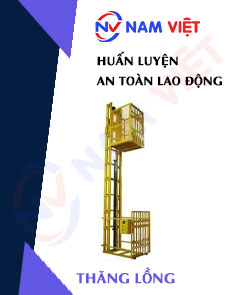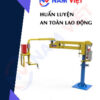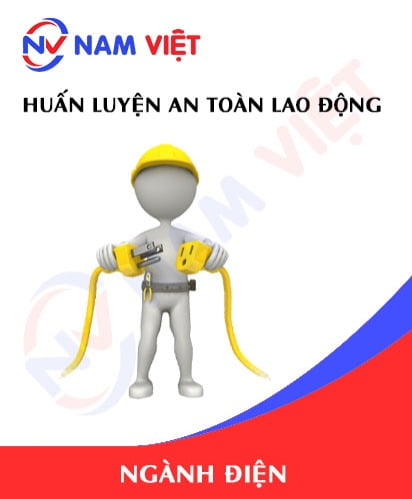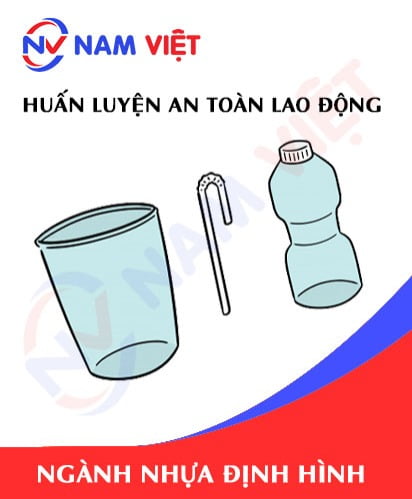Occupational safety training for operating cage hoists
99,000 ₫
Note: The price above is calculated for one person, and it may vary depending on the number of participants in the training course and market fluctuations. For more accurate pricing support, please refer to the quotation table or contact our consulting staff directly.
Occupational safety is an important issue when operating cage lifts and must be addressed promptly to ensure the health and safety of workers while enhancing the reputation of businesses. The Occupational Safety Training course is one of the effective solutions to raise awareness about preventing workplace accidents for workers when operating cage lifts.
Table of Contents
Toggle1. Overview of Cage Hoist
a. What is a Cage Hoist?
A cage hoist is a mechanical device used to transport people and goods up and down in construction sites, factories, warehouses, or any work requiring vertical movement. Cage hoists are usually mounted on columns, lift towers, or other mechanical structures to provide a safe and efficient means of moving personnel and materials.
A typical cage hoist includes an elevator (or cable and pulley system) to lift and lower the cage or container holding people and goods. This elevator is controlled via a control unit or panel either on the ground or on the cage itself, allowing the operator to manage movement and stop at the required levels.

b. Applications of Cage Hoist in Production
Cage hoists have many important applications in production and industry for moving goods, materials, and workers between floors or locations during the production process. Key applications include:
- Material transport: Cage hoists are used to lift and lower raw materials from different levels or locations within the production process, ensuring efficient material supply.
- Product movement: After products are completed, cage hoists can move them from production floors to assembly or packaging levels, increasing productivity and reducing transition times.
- Assembly and maintenance: Cage hoists provide convenient access for workers and tools to elevated positions for assembly, repair, or maintenance of production equipment.
- Personnel transport: In some cases, cage hoists can move workers between work levels or from the ground to higher platforms, which is especially important in factories and industrial facilities.
- Food and beverage production: Cage hoists are used to transport raw materials, intermediate products, and finished goods between floors in food production facilities.
- Automotive industry: In car manufacturing, cage hoists move components and vehicles between floors for assembly and finishing.
- Chemical and oil & gas industry: Cage hoists play a key role in transporting and storing chemical and oil products within factories and production facilities.

c. Fields Using Cage Hoists
Cage hoists are used across various industries to transport personnel and goods between floors or locations. Main fields include:
- Construction: Cage hoists lift and lower materials, workers, and tools from the ground to higher floors in building, bridge, or large construction projects.
- Industry: Factories use cage hoists to move materials, products, and workers between work levels or machinery.
- Warehousing and logistics: Cage hoists facilitate moving and storing goods on different warehouse levels and distribution centers.
- Food and beverage: Production facilities use cage hoists to transport raw materials and products between production and packaging levels.
- Automotive: Cage hoists move components and vehicles between production floors in car factories.
- Chemical and oil & gas: Facilities use cage hoists to transport and store chemical and petroleum products safely.
- Real estate: High-rise buildings may use cage hoists for moving people and goods between floors.
- Healthcare: Hospitals and medical facilities may use cage hoists to transport patients and medical equipment between floors and rooms.
2. Overview of Safety Training for Cage Hoist Operation
a. What is Occupational Safety Training?
- Occupational safety training for cage hoist operation consists of sessions designed to raise awareness about preventing workplace accidents. Workers directly operating cage hoists fall into group 3.
- Safety training helps workers identify and avoid hazards, reducing the risk of accidents during work.
REGISTER FOR OCCUPATIONAL SAFETY TRAINING SERVICE
b. Training Duration
Initial safety training duration:
- Total training time is at least 24 hours, including assessment time.
- 8 hours of theory on safety and labor hygiene policies and laws
- 8 hours of theory on basic occupational safety and hygiene knowledge
- 4 hours of theory on specialized training content
- 2 hours of practical training on specialized content
- 2 hours of theoretical exam at the end of the course
The training center schedules multiple sessions depending on workers’ availability. Typically, there are 6 sessions over 3 days if the company allows continuous attendance.
Periodic safety training:
- Before the occupational safety card expires, workers must undergo periodic safety training for renewal. Periodic training duration must be at least 50% of the initial training duration.
Explanation: The total periodic training duration is at least 12 hours, including assessment. Upon completion and passing the test, workers receive a renewed occupational safety card.
c. Training Content
| No. | TRAINING CONTENT | TRAINING DURATION (HOURS) | |||
| Total | Including | ||||
| Theory | Practice | Assessment | |||
| I | Policies and occupational safety and hygiene laws | 8 | 8 | 0 | 0 |
| 1 | Overview of legal documents system regarding occupational safety and hygiene. | 6 | 6 | ||
| 2 | System of safety and hygiene standards and regulations. | 1 | 1 | ||
| 3 | Specific regulations from state authorities on occupational safety when constructing, expanding, or renovating facilities, and handling machinery, equipment, and materials requiring strict safety standards. | 1 | 1 | ||
| II | Basic occupational safety knowledge | 8 | 8 | 0 | 0 |
| 1 | Basic knowledge of hazardous factors at the workplace. | 4 | 4 | ||
| 2 | Methods to improve working conditions. | 1 | 1 | ||
| 3 | Safety culture in production and business. | 1 | 1 | ||
| 4 | Rights and obligations of employers and workers; policies on occupational safety and hygiene; functions of the safety network and safety officers. | 1 | 1 | ||
| 5 | Safety regulations, signs, personal protective equipment, first aid skills, and occupational disease prevention. | 1 | 1 | ||
| III | Specialized training content | 6 | 4 | 2 | 0 |
| Comprehensive knowledge of machinery, hazardous substances; risk analysis, safety management, safe working procedures with equipment and hazardous materials. | 6 | 4 | 2 | ||
| IV | End-of-course safety assessment | 2 | 2 | 0 | 0 |
| Total | 24 | 22 | 2 | ||
See more training content of 6 groups
d. Occupational Safety Card
After completing the occupational safety training and passing the assessment, workers are issued an occupational safety card (commonly called group 3 safety certificate).
The card shows details such as full name, date of birth, job, working environment, training duration, red stamp, and signature confirming course completion.
According to regulations in Clause 2 of Article 24 of Decree 44/2016/ND-CP, there are two cases:
- If the employer and employee have an employment contract, the employer must sign, stamp, and seal the card after the employee completes the group 3 training and passes the assessment.
- If the worker is freelance or seasonal without a contract, the training unit must sign, stamp, and seal the card after the worker completes the training and passes the assessment.

3. Hazards When Operating Cage Lifts
Operating cage lifts can involve many hazards, and ensuring safety during their use is very important. Below are some common hazards when operating cage lifts:
- Falls from height: The risk of falling from height is one of the main hazards when using cage lifts. This can happen to both people and cargo if safety rules are not followed.
- Fire: Fire risks always exist in industrial environments, and a fire can disable a cage lift or endanger those using it.
- Technical failures: Technical errors or breakdowns of elevators or cage lift systems can lead to accidents.
- Overloading: Overloading the elevator or cage lift can cause malfunctions or collapse, threatening the lives of users.
- Operator error: Cage lift operators must follow all regulations and instructions to avoid mistakes that could lead to accidents.
- Weather impact: External conditions such as strong wind, rain, snow, or hail can affect cage lift operations and increase accident risks.
- Design and maintenance: Elevators and cage lifts must be properly designed and regularly maintained to ensure safety.
- Safety gaps: Lack of safety measures such as windows or safety locks can lead to the risk of people or cargo falling.
- Failure to ensure personal safety: Neglecting to use personal protective equipment such as helmets, safety harnesses, and other protective gear can pose risks to users.
To address these hazards, it is necessary to comply with all safety rules and the manufacturer’s and safety training organization’s instructions. Ensuring that elevators and cage lifts are regularly maintained and safety-checked helps reduce accident risks.

4. Measures to Control Workplace Accidents When Operating Cage Lifts
To control workplace accidents when operating cage lifts, a range of safety measures must be implemented. Below are important measures to ensure safety during cage lift use:
- Safety training: Ensure that all cage lift operators and workers using cage lifts are fully trained in equipment use, safety rules, and emergency procedures.
- Load classification: Comply with the weight limits specified for elevators and cage lifts. Avoid overloading, as it can cause collapse or malfunction.
- Personal protective equipment: All cage lift users must wear personal protective equipment, including helmets, safety shoes, and harnesses.
- Safe cargo handling: When transporting goods, ensure they are securely fastened to prevent falling or uncontrolled movement.
- Control checks: Inspect elevator and cage lift controls to ensure proper operation and verify that all safety functions are working.
- Monitoring and compliance: Use monitoring systems and management measures to ensure all users follow safety rules and perform tasks safely.
- Emergency stop: Install emergency stop devices to halt elevators or cage lifts in urgent situations.
- Regular maintenance schedule: Conduct regular maintenance to ensure equipment remains stable and safe.
- Emergency guidance: Train personnel on emergency procedures and how to respond to hazardous situations.
- Compliance with safety regulations and standards: Follow all regulations and safety standards related to elevator and cage lift usage.
- Accident reporting and analysis: In case of an accident, investigate causes and implement measures to prevent recurrence.
- Periodic inspection of cage lifts to detect safety issues such as wear, damage, or mechanical failures early, reducing workplace accident risks.

5. Benefits of Workplace Safety Training
An Toan Nam Viet provides your business with the following benefits after completing safety training courses in accordance with Decree 44/2016/ND-CP on occupational health and safety:
- Workers can identify potential workplace hazards and take preventive measures to avoid accidents.
- Your business can establish risk prevention measures in production, operation, and maintenance processes.
- Reduce costs associated with workplace safety incidents.
- Uninterrupted production enhances labor productivity and product quality.
- Ensure compliance with occupational safety laws, avoiding legal risks.
- Build credibility and professionalism, enhancing your company’s brand image.
Nam Viet’s training courses help individuals prevent external hazards that could cause injury or even death.
REGISTER FOR WORKPLACE SAFETY TRAINING SERVICE
6. Customer Feedback After Completing Training
An Toan Nam Viet has many years of experience collaborating with businesses across Vietnam, especially in the southern provinces. This responsibility is very valuable, which is why our workplace safety training is increasingly professional. The motivation for our growth comes from positive feedback and suggestions from our clients. Below are some testimonials from partners we have served:
Bac Nam E&C Investment and Construction JSC
“My first experience using An Toan Nam Viet services was very surprising due to the 24/7 support from the consulting team. The class organization was quick and convenient for our company. Thank you very much for Nam Viet’s service!”
See more customer interviews after using our services from An Toan Nam Viet
7. An Toan Nam Viet’s Workplace Safety Training Capacity
An Toan Nam Viet is a reputable and high-quality workplace safety training center in Vietnam. Training sessions are continuously held at production workshops, factories, and construction sites nationwide (63 provinces in Vietnam).
REGISTER FOR WORKPLACE SAFETY TRAINING SERVICE
Workplace safety training license
- An Toan Nam Viet has been inspected and certified by the Department of Labor Safety, Ministry of Labor – Invalids and Social Affairs, confirming our qualifications for workplace safety training. This reinforces our training capability.

Materials and lectures
- Before being used in workplace safety training courses, all training materials are reviewed to ensure accuracy and effectiveness.
- Teaching methods are standardized according to An Toan Nam Viet standards, designed by occupational safety training experts to maximize knowledge absorption.
Facilities
- Controlling classroom factors improves teaching efficiency and knowledge retention.
- Training facilities provide spacious classrooms meeting standards for area, lighting, and training equipment.
8. National Reputable Safety Training Center
At An Toan Nam Viet, we prioritize professional occupational safety training. Teaching workers how to protect themselves contributes to building the nation.
To ensure effective training, we carefully prepare every detail, from tools, teaching equipment, curriculum, materials, to lighting and sound.
Our instructors are experts with many years of experience. They have conducted research identifying hazards across industries and methods to prevent them.
Lectures are practical, engaging, and easy for workers to understand, enhancing knowledge retention. All content complies with Decree 44/2016/ND-CP.
Participants learn safety measures and how to apply them effectively in their work.
Our training center is proud to provide professional workplace safety training with advantages such as:
- Competitive training costs with high quality.
- Flexible scheduling according to company production.
- Fast certification procedures complying with law.
- Experienced instructors.
- Controlled classroom factors improve teaching efficiency and learning outcomes.
- Customized training materials suitable for company safety requirements.
- Dedicated and professional support to clients quickly and accurately.

9. Additional Workplace Safety Training Resources
- Safety materials for cage lift operation
- Workplace safety training materials
- Workplace safety training tests
1 review for Occupational safety training for operating cage hoists
No comments yet















phanminhhang341
Good labor safety unit